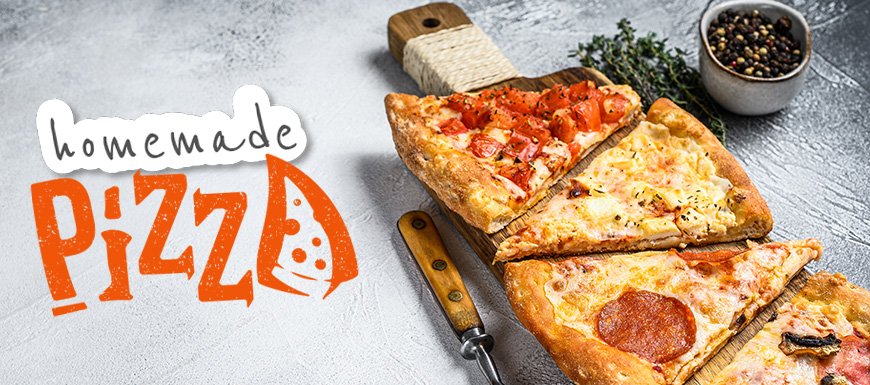
Pizza has always been the ultimate Friday night go to or easy weekend dinner. When most people think of pizza, they usually think of take-out or frozen. Little do people consider traditional Neapolitan pizza. A crispy yet soft crust, with dark caramelized spots and gooey cheese.
For most, homemade pizza may seem unachievable, however, it is extremely easy to make. As long you have the right ingredients and follow a few basic tips, you can have easy homemade pizza.
Anything and everything you need to make an amazing at home pizza can be found at Vincenzo’s either in-store or online. Check out Vicenzo’s for all your pizza making needs.
The first thing you need to consider when you are making pizza at home is the dough. You have a few options when it comes to picking your pizza dough:
Pre-made and risen dough
Pre-cooked dough rounds
Alternatives I.e., pita’s, English muffins, cauliflower crust, etc.
Homemade dough
All these options work great for different types of people and pizza. However, there are a few things to look out for when deciding on your dough of choice. If you go for a pre-cooked or dough alternative then you are pretty much good to go, however, you will not get the authentic Neapolitan pizza with either. If you choose to go with a pre-made, dough mix, or homemade dough than you need to look for one very important ingredient; double zero flour (00 flour).
00 flour is what gives pizza its signature crust. In Italy 00 does not refer to the protein or gluten content in the flour, like here. It refers to the fineness of the grind. In Italy the grind of flour can range from 00 to 2, with 00 being the finest and 2 being coarse. It is considered the golden standard for Neapolitan pizza.
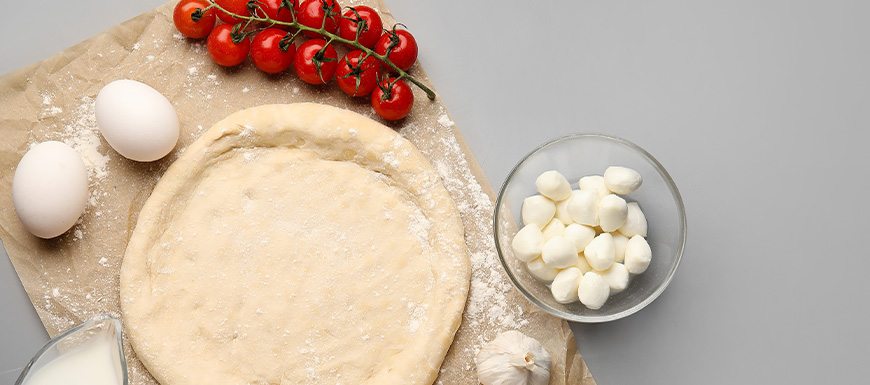
The most common question people ask when making their own dough is: Can I just use All Purpose (AP) flour instead? Simply the short answer is yes, but not if you want the best pizza possible. The main differences between the two types of flour you need to consider are:
Wheat: 00 flour is made from soft wheat or durum wheat (also called pasta wheat), AP flour is made from a combination of hard wheat and soft wheat.
Protein: 00 flour is high in protein with low gluten giving the pizza its signature light, crispy crust, AP flour or bread flour are both high in protein and gluten giving it a more dense and chewy crust.
Texture: grind size affects the hydration of the dough, 00 flour is a very fine grind meaning it requires less water and has a less chewy texture, AP flour is a coarser grind and requires more water, meaning it needs to be worked more and has a chewier texture.
Theoretically you can use AP flour to make pizza dough or buy pizza dough with AP flour in it. However, you will not have the same results as you would if you used 00 flour. With 00 flour you can achieve that restaurant quality of dough at home in your kitchen. You can pick up 00 flour or pizza dough mix at Vincenzo’s online or in-store today.
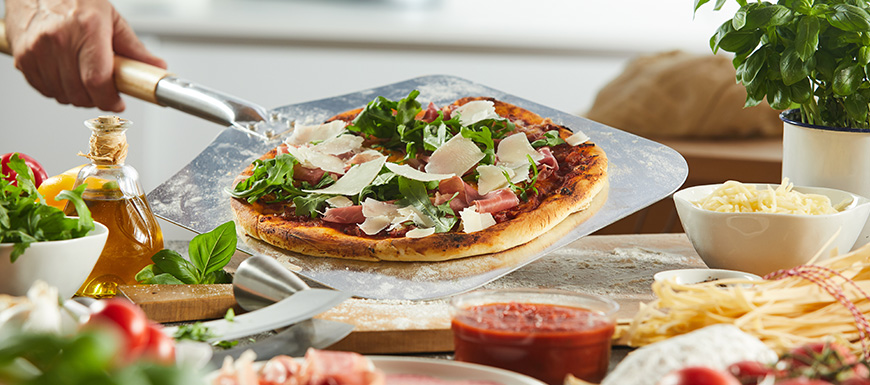
First of all, what is a pizza peel? A pizza peel or paddle is the tool used to place and remove your pizza from the oven or wood burning stove. It is the long metal or wooden paddle used by pizza chefs to get the pizza in and out of the oven.
Most at home cooks do not necessarily own a pizza peel, but does that mean that they cannot make pizza at home? No, they can most certainly make pizza at home without a peel, however, it would be easier with one.
Simple trick for those without a peel is to flip a baking sheet over and use the flat bottom. Just simply cover it in flour or cornmeal like you would a peel and you can use it to get your pizza in and out of the oven.
Using a baking sheet instead of a peel does however make things a little more challenging. Because a baking sheet is not flat or does not taper at the end like a peel it makes it much harder to get the pizza back on it to get it out of the oven. It also makes it more difficult if you need to rotate your pizza at any point during the cooking process.
Using a peel can greatly improve your home pizza making experience. Peels allow you to easily place and remove your pizza from your oven. However, like all things there are different types of peels and options that all affect your cooking experience.
Metal Peels: typically made from aluminum, are very thin but still strong
Wooden Peels: made from all different types of wood, often tapered at the end, harder to clean, doubles as a serving plate, more atheistically pleasing
Long Handle: has a longer handle, typically meant for large wood burning pizza ovens or outdoor ovens
Short Handle: meant more for at home cooking or commercial kitchens
Removable Handle: some peels, mainly metal, have removeable handles for ease of clean, especially if the handle and paddle are made of different materials
Non-stick: some peels are made form a non-stick metal meaning you do not need to add extra flour or cornmeal to the peel if the bottom of the pizza is floured enough
Perforated: made to make the pizza moving and turning process easier, uses less flour and cornmeal
Different types of peels can be used for a variety of different reasons. However, when it comes down to it, it is all up to personal preference. Not everyone will prefer the same type of peel when they are cooking at home. Some may require larger long handle peels if they have a big wood oven or if they prefer not to get too close to their hot oven. Some may prefer non-stick to make the moving process easier. Some may prefer wood so that it can double as a serving plate. It is all up to the individual cook and what they prefer.
If you are looking for a good pizza peel of your own check out Vincenzo’s online or in-store to find the Boska – Pizza Peel Shovel.
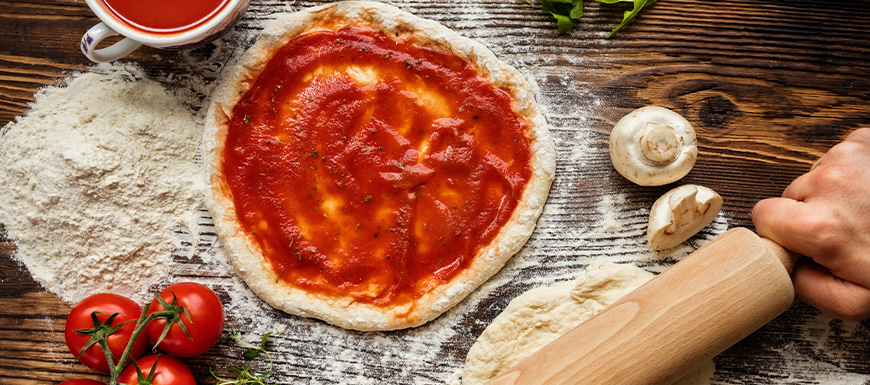
Pizza sauce may be the last thing on your mind when you decide to make homemade pizza. An afterthought that you can just pick up from the store. However, pizza sauce the basis for your pizza’s flavour palate and the foundation to build upon. You need to ensure that you have the best sauce possible.
There are typically two routes you can go down, store bought or homemade. Both are good and work for people in different ways. People pick store bought for a variety of reasons, busy life, easier, afraid to mess up homemade, etc. Going store bought can be great choice if you get a good brand. Vincenzo’s offers a variety of brands both in-store and online that will help elevate your pizza making experience.
If choose to go with homemade sauce instead, you can find some amazing recipes that only take five minutes. Homemade pizza sauce is surprisingly easy to make, all you need is crushed tomatoes, garlic, extra virgin olive oil, fine sea salt, and dried oregano. If you would prefer you can add in other seasonings such as garlic powder, onion powder, dried basil, etc. You simply just throw all your ingredients into a blender and mix them until they are all combined and leave them in the fridge for 3 hours – 7 days to allow the flavours to marry. You can then store it in your fridge in an air tight container for up to two weeks or in your freezer for a couple of months.
Now not everyone likes or cannot have simple tomato sauce on their pizza. There are certainly plenty of other sauces to choose from if you would prefer something else. The most popular are:
Pesto
Creamy alfredo sauce (white sauce)
BBQ sauce
Ricotta cheese
Ranch
Olive oil with garlic
Balsamic glaze
Not all these sauces are traditional but can provide a variety of different flavour pairings. They are also a great option for anyone with allergies or aversions.
If you are looking to make your own sauce at home, you can pick up all the necessary ingredients from Vincenzo’s online or in-store. If you would prefer one of the alternative sauces, you can also pick them up pre-made or the ingredients to make them from Vincenzo’s as well.
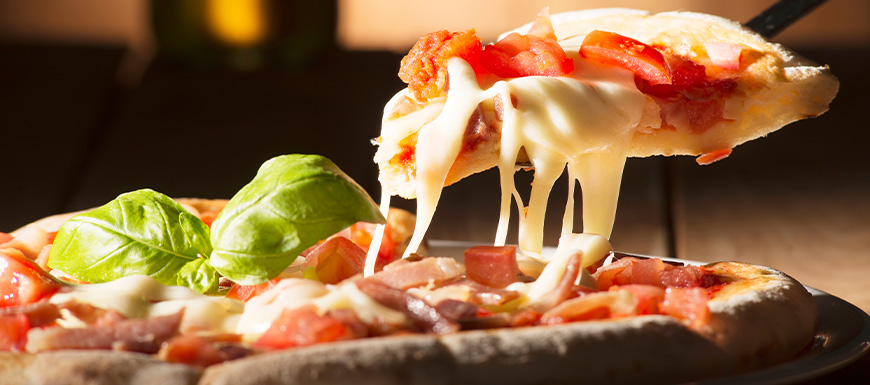
Creating the best at home pizza can seem to be a daunting challenge for most home cooks. However, it can be relatively simple with a few easy tips and tricks.
Cook your pizza on a pizza stone: a pizza stone is an integral part to getting the perfect crust at home.
a. Make sure your oven is as high as it can go, around 450-500 degrees F (250-260 degrees C)
b. Place the stone on the lowest rack of your oven while the oven pre-heats to allow the stone to pre-heat as well
c. If you want thicker crust 400 degrees may be preferred to allow the crust to cook without over cooking or burning the toppings
d.For a crunchier crust add a cast iron pan or baking sheet to the bottom of the oven with the pizza stone and then put some ice into the pan or baking sheet after you add the pizza to create steam
e. When putting your pizza in the oven place your peel against the back edge of the stone and in one swift motion jerk the peel back, and if you did it correctly, the pizza should be centered on the stone
Dust your Peel with flour or cornmeal: this is common knowledge but dusting your peel with flour or cornmeal allows you to remove the pizza more easily. Be generous so your dough doesn’t stick.
Brush the crust with Olive oil: for a more golden and crispy crust, rather than the typical dusty spotted crust, brush the crust with olive oil before putting it into the oven and right after you remove it.
Layering: when layering your pizza make sure you are doing it in the correct order to avoid extra moisture, burning, and to get an even cook. It should be sauce first, herbs, cheese, and then meat/veggies.
Room temperature dough: leave your dough out for 30 minutes to an hour before you want to make your pizza to allow it to come to room temperature, this helps relax the gluten.
Do not use a rolling pin: when getting your dough into a flat circle for your pizza do not use a roller. It will flatten all the air bubbles in your dough and create a thin burnt crust.
Check on the pizza: check on your pizza about five minutes into cooking to see if it needs to be rotated for more even cooking.
Medium to dark brown: you will know your pizza is done when the crust is risen, and your cheese is a medium to dark brown.
Soggy crust: avoid soggy crust by using only a thin layer of sauce and removing as much moisture from other toppings as possible before cooking.
Avoid wet cheeses: fresh mozzarella and other wet cheeses can cause your pizza to become soggy, if you really love them and wish to use them cut them into thin slices.
Pre-cook: pre-cook most of your fresh ingredients such as veggies and meats as they will not be able to fully cook with the rest of the pizza in the oven.
Cooling rack: when your pizza is finished place it on a cooling rack to avoid steaming.
Fresh herbs: add all fresh herbs at the very end after your pizza is out of the oven and for the best taste, right before serving.
Making pizza at home can seem challenging or hard at first, but with a few simple tool and tricks you can have homemade pizza every night. For most of the tools and ingredients mentioned throughout the blog, please check out Vincenzo’s online or come visit us in-store.
